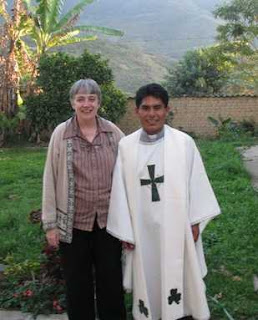
Photo: New graduate Pánfilo harvesting leaves of one of his insecticidal plants, hualusa de monte.
Then Sonia Cordero defended her project. She compared different kinds and mixes of substrates in different sized pots for coffee seedling production, and found that a mix of 25% chicken manure with 75% soil in the largest available plastic pots was the best solution for our coffee farmers. Her experiment was very complex, and she struggled to finish, and we were all very proud of her fortitude and dedication.
Both students made special mention of Sister Damon and how she encouraged them throughout their time at the college. Though our foundress is not close in physical geography, she is very close in the geography of our hearts. Thank you, Sister Damon, for your vision and your love that helped these students' dreams become reality.







